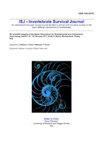红枣梗螟对免疫攻击的血细胞谱、吞噬和抗菌活性研究
IF 1.2
4区 农林科学
Q4 IMMUNOLOGY
引用次数: 2
摘要
枣梗螟虫是沙特阿拉伯枣椰树的一种破坏性害虫。我们通过在腹腔内注射脂多糖(LPS)(一种病原体相关的分子肽,PAMP)来评估第三龄(最后一龄)的免疫反应,它显著增加了总血细胞计数。相衬光镜显示有五种血细胞类型:原血细胞、粒细胞、浆细胞、嗜性腺细胞和球状细胞。透射电镜显示,在这些血细胞中,只有粒细胞和浆细胞吞噬乳胶珠。注射LPS也显著降低了类卵巢细胞的数量。琼脂孔扩散法测定注射LPS的幼虫血浆蛋白对革兰氏阳性菌和革兰氏阴性菌的抑菌活性,根据菌株、血浆蛋白总浓度和注射后时间的不同而不同。本研究结果对线虫的生物防治具有一定的指导意义。此外,还可以在秀丽隐杆线虫中发现具有抗菌活性的新化合物,这些化合物可能有助于开发天然来源的创新药物。本文章由计算机程序翻译,如有差异,请以英文原文为准。
Hemocyte profile, phagocytosis, and antibacterial activity in response to immune challenge of the date fruit stalk borer, Oryctes elegans
The date fruit stalk borer, Oryctes elegans Prell, is a destructive pest on date palms in Saudi Arabia. We evaluated the immune response of the third instars (last instars), by the intrahemocoelic injection of lipopolysaccharide (LPS) (a pathogen-associated molecular peptide, PAMP), which significantly increased the total hemocyte count. Phase-contrast light microscopy revealed the presence of five hemocyte types: prohemocytes, granulocytes, plasmatocytes, oenocytoids, and spherulocytes. Transmission electron microscopy demonstrated that, among these hemocytes, only the granulocytes and plasmatocytes phagocytosed latex beads. Injection with LPS also significantly decreased the number of oenocytoids. The antibacterial activity of plasma proteins of larvae injected with LPS, measured using the agar well diffusion method, against Gram-positive and Gram-negative bacteria varied based on the bacterial strain, the total concentration of plasma protein, and time post-injection with LPS. The results of the current study may be useful in the biological control of O. elegans. Furthermore, new compounds with antibacterial activity that might be useful for the development of innovative drugs of natural origin can be identified in O. elegans.
求助全文
通过发布文献求助,成功后即可免费获取论文全文。
去求助
来源期刊

ISJ-Invertebrate Survival Journal
IMMUNOLOGY-ZOOLOGY
CiteScore
2.10
自引率
0.00%
发文量
0
审稿时长
>12 weeks
期刊介绍:
Invertebrate Survival Journal (ISJ) is an international and open access journal devoted to prompt and innovative studies on the basic defense mechanisms in invertebrates, in particular with a view to identifying biotechnologies able to act against derived diseases and related economic damage.
Contributions will be mainly in the form of Letters to the Editor, Visions and Perspectives, Short Communications, Technical Reports, Research Reports, Review, Minireview and Reports of Meetings. Letters to the Editor can be commentaries or perspectives on invertebrate defence mechanisms or replies to the data published in ISJ.
 求助内容:
求助内容: 应助结果提醒方式:
应助结果提醒方式:


